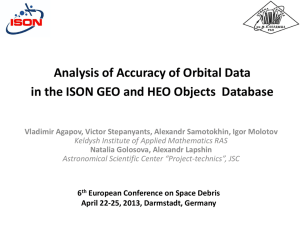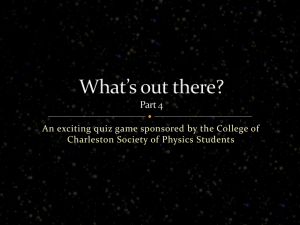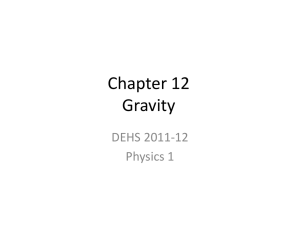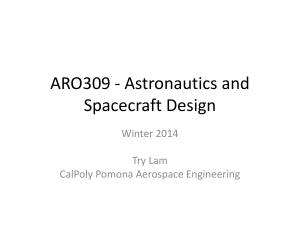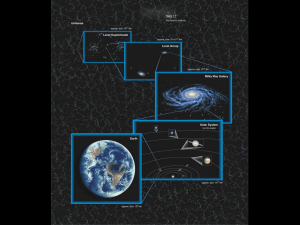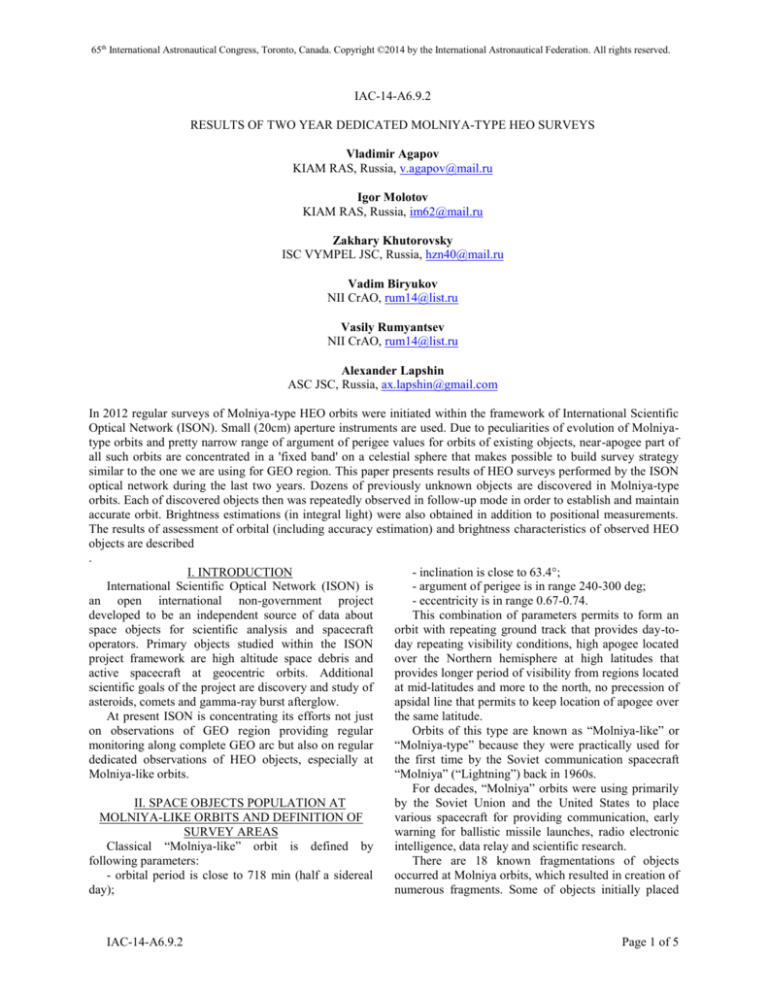
65th International Astronautical Congress, Toronto, Canada. Copyright ©2014 by the International Astronautical Federation. All rights reserved.
IAC-14-A6.9.2
RESULTS OF TWO YEAR DEDICATED MOLNIYA-TYPE HEO SURVEYS
Vladimir Agapov
KIAM RAS, Russia, v.agapov@mail.ru
Igor Molotov
KIAM RAS, Russia, im62@mail.ru
Zakhary Khutorovsky
ISC VYMPEL JSC, Russia, hzn40@mail.ru
Vadim Biryukov
NII CrAO, rum14@list.ru
Vasily Rumyantsev
NII CrAO, rum14@list.ru
Alexander Lapshin
ASC JSC, Russia, ax.lapshin@gmail.com
In 2012 regular surveys of Molniya-type HEO orbits were initiated within the framework of International Scientific
Optical Network (ISON). Small (20cm) aperture instruments are used. Due to peculiarities of evolution of Molniyatype orbits and pretty narrow range of argument of perigee values for orbits of existing objects, near-apogee part of
all such orbits are concentrated in a 'fixed band' on a celestial sphere that makes possible to build survey strategy
similar to the one we are using for GEO region. This paper presents results of HEO surveys performed by the ISON
optical network during the last two years. Dozens of previously unknown objects are discovered in Molniya-type
orbits. Each of discovered objects then was repeatedly observed in follow-up mode in order to establish and maintain
accurate orbit. Brightness estimations (in integral light) were also obtained in addition to positional measurements.
The results of assessment of orbital (including accuracy estimation) and brightness characteristics of observed HEO
objects are described
.
I. INTRODUCTION
- inclination is close to 63.4°;
International Scientific Optical Network (ISON) is
- argument of perigee is in range 240-300 deg;
an open international non-government project
- eccentricity is in range 0.67-0.74.
developed to be an independent source of data about
This combination of parameters permits to form an
space objects for scientific analysis and spacecraft
orbit with repeating ground track that provides day-tooperators. Primary objects studied within the ISON
day repeating visibility conditions, high apogee located
project framework are high altitude space debris and
over the Northern hemisphere at high latitudes that
active spacecraft at geocentric orbits. Additional
provides longer period of visibility from regions located
scientific goals of the project are discovery and study of
at mid-latitudes and more to the north, no precession of
asteroids, comets and gamma-ray burst afterglow.
apsidal line that permits to keep location of apogee over
At present ISON is concentrating its efforts not just
the same latitude.
on observations of GEO region providing regular
Orbits of this type are known as “Molniya-like” or
monitoring along complete GEO arc but also on regular
“Molniya-type” because they were practically used for
dedicated observations of HEO objects, especially at
the first time by the Soviet communication spacecraft
Molniya-like orbits.
“Molniya” (“Lightning”) back in 1960s.
For decades, “Molniya” orbits were using primarily
II. SPACE OBJECTS POPULATION AT
by the Soviet Union and the United States to place
MOLNIYA-LIKE ORBITS AND DEFINITION OF
various spacecraft for providing communication, early
SURVEY AREAS
warning for ballistic missile launches, radio electronic
Classical “Molniya-like” orbit is defined by
intelligence, data relay and scientific research.
following parameters:
There are 18 known fragmentations of objects
- orbital period is close to 718 min (half a sidereal
occurred at Molniya orbits, which resulted in creation of
day);
numerous fragments. Some of objects initially placed
IAC-14-A6.9.2
Page 1 of 5
65th International Astronautical Congress, Toronto, Canada. Copyright ©2014 by the International Astronautical Federation. All rights reserved.
into Molniya-type orbit are decayed already. All intact
objects (functional and non-functional spacecraft, upper
stages) and fragmentation debris remaining on orbit at
present are scattered in a huge volume of near-Earth
space due to difference in long-term orbital evolution.
This volume can be characterized by following
parameters:
- orbital period range: 600-800 min;
- inclination range: 60°-73°;
- argument of perigee: not constrained;
- eccentricity range: 0.42-0.75.
Using above criteria one can select a subset of
known population of orbital objects tracking on a
regular basis. Results of analysis of dispersion of orbital
parameters for this population can be used further for
definition of possible areas for establishing optical
surveys.
There are two sources of orbital data which we have
used to define search areas for objects at Molniya-like
orbits. These are SpaceTrack Web-site with data
provided by the U.S. STRATCOM and ISON own
database of orbital data derived from optical
measurements.
As of Sep 15, 2014, criteria described above were
satisfied for 276 objects with orbital data provided at
SpaceTrack and 30 additional objects discovered by
ISON prior to 2012 and having orbital information
updating on a regular basis. These figures were not
much different in the beginning of 2012 when we
decided to start surveys of Molniya-like orbits.
Therefore, it is possible to use current population to
explain how survey areas are selected.
Fig. I: Distribution of Molniya-type HEO objects
extracted from KIAM/ISON database by period and
argument of perigee.
Looking at the distribution of objects by period and
argument of perigee (Figure I) one can say that due to
evolution objects are not dispersed evenly across the
parametric space but are grouping in a few clusters.
Objects having argument of perigee in range 240°-300°,
form the largest one. These objects do have good
visibility for the Northern hemisphere observation
IAC-14-A6.9.2
facilities while passing near-apogee part of the orbit.
Objects having argument of perigee in range 60°-120°,
form the second large cluster. Apogee of orbits for these
objects is located over the mid-latitudes but of the
Southern hemisphere that prevents simultaneous
observations of objects of these group with objects of
the first group due to large difference in angular
velocities with respect to an observer located in the
Northern hemisphere. There are three other clusters
formed by a smaller number of objects with argument of
perigee of their orbits close to either 0° or 180°. This
makes possible the discovery of such objects in regular
GEO surveys. Therefore, these objects can excluded
from consideration at this stage.
Fig. II: Distribution of Molniya-type HEO objects
extracted from KIAM/ISON database by inclination
and argument of perigee.
The distribution of objects by inclination and
argument of perigee (Figure II) demonstrates similar
clustering with that difference that objects having
inclination of their orbits in range 60°-65° do have
apogee located over the Northern hemisphere while
objects having inclination of their orbits in range 66°72° do have apogee located over the Southern
hemisphere. So, one can expect that if to establish
surveys at mid-latitude Northern hemisphere facility
then absolute majority of discovered objects should
have inclination in range 60°-65°.
Looking at the distribution of objects by period and
inclination (Figure III) one can say that due to higher
inclinations objects of interest should be better visible
(at higher elevation angles) at mid-latitude observation
facilities. From the one hand, this is good, because
absolute majority of ISON facilities are located in the
Northern hemisphere at mid-latitudes. From the other
hand, this is bad because significant portion of the nearapogee pass for objects having argument of perigee in
range 270°-310° is projecting at the celestial sphere on
areas close to galactic plane densely populated by stars
making the detection of moving faint objects very
challenging.
Page 2 of 5
65th International Astronautical Congress, Toronto, Canada. Copyright ©2014 by the International Astronautical Federation. All rights reserved.
Characteristic
Aperture
Equivalent focal length
Focal ratio
FOV angular diameter
FOV linear diameter
Image scale
CCD type
180 mm
294 mm
f/1.63
10°
51.6 mm
~1.43 µm/arcsec
FLI ML9000 (3056x3056
pix, 12 µm)
Resulting FOV
7.1°x7.1°
Optics type
catadioptric system
Table I: Characteristics of VT-52c telescope
Fig. III: Distribution of Molniya-type HEO objects
extracted from KIAM/ISON database by period and
inclination.
Finally, it should be noted that solar phase angle
value is significantly varying for near-apogee passes of
objects at Molniya-like orbits. Moreover, during
summer time, when nights are shortest at the Northern
hemisphere mid latitudes, observation conditions are
least favourable for these objects due to larger solar
phase angles values resulting in much fainter brightness.
Taking into account all described peculiarities of the
current distribution of orbital parameters for objects at
Molniya-like HEO it was decided to concentrate our
efforts on performing surveys of areas close to nearapogee passes targeting at objects having inclination of
their orbits in range 60°-65° and argument perigee in
range 240°-300°.
III. OBSERVATION INSTRUMENT
It is obvious that in order to cover as many orbits of
objects belonging to the selected group as possible it is
required to survey large areas on the celestial sphere.
Taking into account additional requirements on minimal
number of measured positions as well as overall
observation arc length for each observed object it
becomes evident that only wide field of view telescope
is capable to solve the task efficiently.
That is why a special optical instrument was
developed in Crimean observatory. It provides large
field of view to cover wide areas of the celestial sphere,
optimal image scale to keep accuracy of angular
measurements at desired level and extremely good
quality of image simultaneously. Characteristics of the
instrument are presented in Table I.
Of course, small aperture is a disadvantage because
it limits threshold of detection of space objects.
However, preliminary estimations showed that with
such instrument it was still possible to detect at S/N
level equal to 3-4 object as faint as 16th magnitude.
Two VT-52c telescopes were produced and installed
at Crimean observatory (Figure IV).
IAC-14-A6.9.2
Fig. IV: Two
observatory.
VT-52c
telescopes
at
Crimean
IV. ANALYSIS OF OBTAINED DATA
Regular surveys of selected apogee area of Molniyalike orbits started in 2012. There were total 458 nights
during which surveys were performed (106 – in 2012,
197 – in 2013, 155 – in 2014 as of Sep 30). More than
417000 measurements of angular position and
brightness were obtained for more than 280 individual
objects, including new ones. Some tracks remained
uncorrelated.
Fig. V: Coverage of surveys of Molniya-type orbits
apogee area in 2014.
Page 3 of 5
65th International Astronautical Congress, Toronto, Canada. Copyright ©2014 by the International Astronautical Federation. All rights reserved.
For surveys performed in 2014 distribution of
obtained measurements in Right Ascension (RA) –
Declination (DEC) space is shown at Figure V. It is
clearly visible that the main coverage area is constrained
by RA values in range 8-19 hours and by DEC values in
range 55°-67°. There are not too many observations
taken in area corresponding to the upper right corner of
this plot due to galactic plane located there.
In addition, as it was expected, not all 306 known
objects were observed. Analysis of orbital parameters of
objects which were not observed showed that absolute
majority of them do have apogee over the Southern
hemisphere that prevents their observation in a survey
targeted to objects with apogee over the Northern
hemisphere. Figure VI provides the explanation of this
fact.
calculated values referring to a zero phase angle and
40000 km distance for all obtained brightness
measurements. Figure VII shows distribution of
obtained standard magnitudes for all objects observed
during 2012-2014 survey program. The median value of
all the measurements obtained for each object was used
as a standard magnitude.
Fig. VII: Distribution of standard magnitudes for all
objects observed in Molniya-like HEO surveys.
Fig. VI: Coverage of surveys of Molniya-type orbits
apogee area in 2014.
There are discovered 53 new objects in total (20 – in
2012, 21 – in 2013 and 12 – in 2014 as of Sep 15).
Though special efforts were devoted to performing
regular observations of all discovered objects, 19 of
those objects are considered lost at present (i.e. are not
observed during last 6 months). Nevertheless, it should
be noted that the total number – 83 – of new and
previously discovered pretty bright (and, thus, large
size) objects corresponds 30 percent increase in the total
population of known large objects in Molniya-like
orbits or 40.3 percent increase in the known population
of the subgroup of objects which was specifically
studied in survey program.
It is interesting to compare physical properties of
previously known and newly discovered objects. There
are at least three characteristics that can be assessed.
The first one is a standard brightness (or magnitude).
All measured values of brightness must be brought to
standard conditions in order to make direct comparison
possible. We considered following set of standard
conditions. Each object is assumed as representing
Lambertian sphere with albedo 0.1. Using the wellknown formula for appropriate phase function we
IAC-14-A6.9.2
The second characteristic assessed is a standard
magnitude variation. Figure VIII shows distribution of
the standard magnitude variation versus the standard
magnitude for each observed object. It is clearly seen
that majority of objects does not demonstrate variation
exceeding 1.5 mag (2σ). Nevertheless, variation of order
1.5-2.5 magnitude are making impossible to detect the
most faint of observed objects all the time.
Fig. VIII: Distribution of a standard magnitude variation
vs. standard magnitude value for all objects
observed in Molniya-like HEO surveys.
Finally, an area-to-mass ratio (AMR) was estimated for
each object based in the process of orbit determination.
All obtained values then were averaged for each object.
Resulting plot showing distribution of the AMR is
presented at Figure IX.
Page 4 of 5
65th International Astronautical Congress, Toronto, Canada. Copyright ©2014 by the International Astronautical Federation. All rights reserved.
Fig. IX: Distribution of average area-to-mass ratio for
all objects observed in Molniya-like HEO surveys.
V. CONCLUSION
Near-apogee region of Molniya-like orbits over the
Northern hemisphere was surveyed during 458
observation nights in 2012-2014 by a single small-class
(19 cm) instrument with wide FOV.
Fifty-three new objects are discovered with even this
small equipment. Nineteen objects are considered lost at
present and special observations sessions are required to
recover them and keep them tracking. In order to do this
efficiently, more powerful instrument have to be used.
For the subgroup of objects at Molniya-like orbits
studied in surveys ISON is tracking at present sixty-four
more objects than the U.S. SSN (based on orbital data
publishing at SpaceTrack). That is 31% increase in the
known population of pretty large space debris objects
(d>0.8 m) for this subgroup (40.3% if to take into
account those objects that are discovered but considered
lost at present).
Population of debris at Molniya-like orbits need to
be studied further using more powerful instruments.
This work was partially supported with program
No. 63 of the Presidium RAS.
IAC-14-A6.9.2
Page 5 of 5

